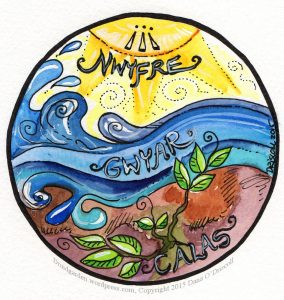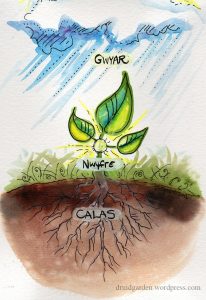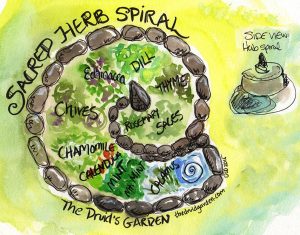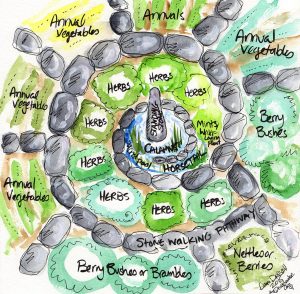By Dana O’Driscoll, Druid Adept and Archdruid of Water
As many on the Druid path know, gardening is a wonderful way that we can interact with nature. By intentionally designing sacred spaces and cultivating them, we not only cultivate a deeper relationship with nature but also help regenerate ecosystems and build habitat for all life. The work of the sacred garden is, inherently, work that happens both within and without. And in principle, creating a sacred garden seems easy enough, but how to bring forth this garden with sacred intent can be challenging. The Druid Revival tradition offers us tremendous resources to intertwine our nature spirituality with our daily living practices, including the work of sacred gardening. While the three Druid elements, nwyfre, calas, and gwyar, are a lesser-known framework within our tradition, they offer us tools for designing sacred gardens and potential rituals for planting and harvesting.
The Three Druid Elements: Nwyfre, Calas, and Gwyar

In order to craft effective ceremonies and design to support sacred gardening, we need an underlying theory that helps us work with various flows of energy. Most people use the well-known four-element framework (earth, air, fire, and water). While the four-element system is heavily discussed in Iolo Morganwg’s Barddas (one of the foundational texts of Revival Druidry), Morganwg also discusses a second elemental framework (later further discussed by John Michael Greer in The Druidry Handbook). The three Druid elements of nwyfre, gwyar, and calas have Welsh names and pronunciations (like many other things coming out of Revival Druidry). They do not cleanly map onto the four elements, so don’t try to see them that way. See them, instead, as an alternative elemental system that emphasizes different properties of the world—all elemental systems do that, generally. They serve as an archetype of things that we can see or experience or know. They are three archetypes, three ways of representing the inner and outer worlds of our experience. My definitions are expanded from the work of Morganwg and Greer.
Nwyfre (NOOiv-ruh)
The first Druid element represents the life force and consciousness within each living being. It is associated with the sky and the heavens; it represents the spirit of things, the mind. The term means sky or heaven in the Welsh language.
Nwyfre in a gardening, growing, or land-healing context refers to the spirit of life flowing through every plant. This is the spark of life that encourages a seed to grow, the magic within the plant; in some forms of herbalism, it would be the spiritual energy of the plant and the plant spirit itself. Nwyfre is not a physical thing (like gwyar or calas, see below); it is the spirit behind the physical thing. Nwyfre is often what we refer to when we talk about things unseen, energies of spaces and people. Nwyfre is also the mental processes associated with gardening—the design work, the thoughtfulness, the planning and careful consideration. It’s the feeling you get when you enter the garden; it’s the awareness that is awakened with a sacred connection to the plants.
Gwyar (GOO-yar)
The second Druid element represents the principle of flow, movement, and change. It is associated with the energy of water (although it is not limited to it); it represents the change that is inherent in all living things. The term means flow or fluidity in Welsh, and we can refer to it as energy flows (in physical manifestation) of all kinds.
Gwyar is responsible for the change we see in plants across the season; it’s the growth of the seed from spout to adult plant and finally decay; it’s the flow of the seasons moving ever forward. Gwyar is the flow of sap in the maple trees that first signals spring; it’s the growth of the plants, the budding and leafing of the trees, the ripening of the fruit, and the eventual composting and decay at the end of the season. Gwyar is the flows of nutrients in the great soil web of all life. It is the principle of gwyar we see in photosynthesis, the conversion of light into energy and oxygen by plants. For home brewers, it is gwyar that allows the physical fermentation and transformation of grain or fruit into alcohol. It is this principle of flow in herbalism, also, that allows the medicine to move from the plant matter into a substance such as tea or tincture. When permaculture designers talk about catching and storing energy, we are referring to harnessing the gwyar in the land for the common good (through rain barrels, swales, solar power, and so on) (for more on permaculture, see Trilithon volume 4, 2017).
Calas (CAH-lass)
The final druid element is calas, representing solidity or substance. Calas is the physical manifestation of things within the world: their form, their substance, and their distinguishing features. This is the Welsh word for “hard” or “stability.”
Calas is the physical being of the plants in the garden, the soil, the microbial life. It is calas you feel when you pick up the rich soil and run it through your fingers. It is calas that is the feeling of your tools in your hand (although it’s gwyar that makes those tools work!). It’s calas that is in the vegetables sitting in your harvest basket and ready for your plate. All of the physical manifestations of your garden—the solidity of the pathways, the size of the beds, the physical structure of the plants, the weight of the stones—these are calas.
Mapping the Elements onto the World

You can map these elements onto another triad in the Druid path—earth (calas), sea (gwyar), and sky (nwyfre). If you are interested in working with these three elements, I would start by suggesting that you spend time meditating on each of them and also spend time examining these principles at work in the world. For example, as I look down my street, I see calas in the pavement, in the trunks of the strong trees, in the physical bodies of the people walking there. I see gwyar in the rain falling on the street, in the movement of the branches in the air, in the swinging of the hands and walking of the people. I see the spark of nwyfre in the laughter of the children crossing the street holding hands in the rain.
As a second example of how these elements manifest in the world, we can think about the honeybee. The honeybee’s physical body (legs, wings, abdomen, exoskeleton, eyes, tongue, and so on) represents calas. The honeybee’s flight and movement in the hive represent gwyar. The alchemical processes of the hive including the spark of life in the eggs, the nectar’s transformation into honey, and the blessing the bees bring to the land all can be represented by nwyfre.
I would suggest that if you want to use these three principles in your sacred gardening work, Druid practice, or daily life, spend time with each of them. Spend time focusing on one, meditating on one, writing about it, maybe sketching it or creating a song, and observing it in everyday life. Do the same with the other two—while these three elements are simple on the surface, profound understanding comes with dedicated study and work with them. Now that we have some understanding of the principles behind the three Druid elements, we can consider how they can be put to work in a sacred garden space.
Using Nwyfre, Gwyar, and Calas in Garden Design
One way we can use the three Druid elements is by considering their role in the garden design process and thinking about integrating them physically into our spaces. We might here think about the interplay between nwyfre (the spark of life) and the flow of water/sunlight and the land/gwyar in order to design our spaces. Let’s look at two such garden designs where these three elements can play a prominent role.
The Herb Spiral
The herb spiral is probably the most quintessential design coming from permaculture; the spiral is built up so that the top is several feet above the earth, making it drier, and creating various small microclimates below. Some spiral designs (including mine in figure 2) include a water feature. I like the herb spiral a lot, as its simple to implement, encourages us to think about the plants and their microclimate needs, and looks great.
From a magical perspective, we can easily apply the three Druid elements to this design: the spiral itself representing nwyfre; the stones, earth, and plants representing calas; and the flow of water and areas of wetness and dryness, as well as the encouraged growth habits based on placement, represent gwyar. It’s also helpful to put a standing stone at the very top, buried a third of its height in the soil.

You’ll notice in the design drawing I’ve included a number of different herbs, many of them with both spiritual and medicinal significance. The top of the design starts with the herbs that like it hot and dry—rosemary and white sage being at the top of that list, perhaps with a bit of accompanying garden sage or clary sage. From there we move into thyme and dill, who like it a bit wetter, along with echinacea (purple coneflower), a wonderful medicinal herb. Basil or lovage, too, would work wonderfully in the middle of the spiral. Chives, chamomile, and calendula fill out the bottom. Next, we get to the pool’s edge. Mountain mint and boneset are two water-loving plants that would like that spot, as would any other mint. Finally, the pool itself can contain horsetail (especially if you are using sand in your pool) or calamus, two rooted and water-loving plants. This design can be modified to your own herbal interest and specific ecosystem.
A Larger Sacred Garden Spiral
We can expand the idea of the herb spiral to create a larger sacred spiral garden for vegetables, perennials, herbs, and pollinator-friendly plants. This image shows a simple design for one that honors these three elements as well as recognizing the importance of an eightfold wheel.

In this design, several stone walkways (or mulched paths) help shape the beds. All of the beds in the spiral should be no more than three to four feet across; it’s harder to manage a bed any wider than four feet. The center of the garden offers a standing stone to channel solar energy into the earth as well as a sacred pool with calamus and horsetail. The edge of the pool, like the design in figure 2, is for water-loving plants, and then any herbs you want to grow work their way outward from the spiral. The outer edges (which can continue beyond what I drew) can be home to perennial berry bushes (blueberry, raspberry, gooseberry, blackberry, etc.) as well as rotating annual vegetable crops. I put nettles at the entrance to serve as guardians for the sacred space. They would require some management, but I note that so many of our forests have those kinds of protectors, and stinging nettle is not only a great guardian of spaces but an incredible medicinal and tasty food.
A Garden/Land Altar Using the Three Elements
Setting up a sacred space in your garden and acknowledging the presence of the elements is an important step to bring an intentional sense of the sacred to your space. To do this, you can use a flat stone or stump. For the three Druid elements, you might simply place a stone for calas, a bowl of water for gwyar, and some representation of nwyfre. Nwyfre might be represented by a symbol like a spiral or an Awen or else some herbs or incense (sage, mugwort, lavender, or any blend of herbs that have a strong connection with planes beyond the physical).
An alternative is to create a living altar, where you can use three plants to represent the elements: a plant with medicinal roots for calas (burdock, comfrey, dandelion, or a mushroom log), a water plant (calamus, horsetail, boneset, mountain mint, cattail, arrowroot) for gwyar, and a plant associated with the spirit realm (sweetgrass, sage) or strongly with the sky (a climbing vine like nasturtium) for nwyfre.
Two Prayers and Blessings for Garden Spaces
A Three-Element Daily Prayer
Here is a simple three-element daily prayer. I like to use something like this when I first enter the garden or at morning’s first light:
Calas, the form and the shape
Gwyar, the flow and the change
Nwyfre, the spark of life
Sacred elements spiraling
Bless this [garden’s/land’s/place’s] growing.
As you say the prayer, pause after each line. If you have a simple three-element altar in your garden, you can touch the elemental representation on the altar as you pause. If you are also engaging in nature meditation, you might use your senses (inner and outer) to observe how calas, gwyar, and nwyfre manifest in your sacred garden (or surrounding landscape).
A Simple Prayer for Growing Things
This prayer, or another like it, can be used to encourage many things to grow, anything from sprouts on your counter or seeds you have started to a new garden. I use this prayer after planting my first sets of seeds in the fertile earth, transplanting seedlings, or putting in new trees or shrubs.
Say, “May the essence of the earth support you in strength.”
Pour a small bit of earth or finished compost over the growing plant, seed, or tree. If you are planting seeds, plant them at this time. As you are sprinkling the earth or planting the seeds, chant “calas” three times and envision the seed’s deep roots and the fertile earth supporting it.
Say, “May the flows of the land transmute you in harmony.”
Pour a small amount of water near the roots of the growing plant or seed. As you are pouring, chant “gwyar” three times and envision the water flowing to the seed and the seed’s growth and change.
Say, “May the spirit of life bless you in wisdom.”
Smudge the plant with a bit of herbal incense (I like sage, mugwort, rosemary, or lavender for this purpose). As you are smudging, chant “nwyfre” three times and imagine a spark of life shining outward from the center of the seed to facilitate its growth.
Say, “May the triune essence of calas, gwyar, and nwyfre infuse you with blessing and abundance.” And chant “Awen” (ah-oh-en) three times to close out the ceremony.
A Three-Element Harvest Blessing
Offering thanks for the harvest can also be done with a simple three-element blessing. This one is not verbal but rather based on movement and meditation and done in silence.
Begin by placing your hand upon the soil at the roots of the plant. Sense the solidity of the soil and the power of the roots and the soil web of life. Offer your silent thanks.
Next, hold the plant, fruit, or vegetable that you plan on harvesting in your hands. Sense within it the swirling life force, nwyfre, and send your thanks into the plant that you are harvesting from.
Harvest the plant. Next, raise your hands with the plant, fruit, or vegetable into the sky, feeling the flowing of the air and energy of the sun present.
Conclude by placing the plant in your harvest basket.
Conclusion
As you can see, the three elements of the Druid tradition provide a wonderful opportunity to work on a sacred level, creating sacred gardening practices. These kinds of practices truly contribute to a magical Druid’s garden where we might commune with nature, rebuild ecosystems, and craft our spiritual life. The above suggestions are only some potentials out of many. May the blessings and inspiration of the three Druid elements flow through your life!
About the Author:
Dana O’Driscoll spent most of her childhood in the wooded hills of the Laurel Highlands region of Pennsylvania, making mud pies, building brush cabins, and eating berries. Thankfully, little has changed, and she can still be found searching out tasty mushrooms, gathering herbs, and playing her pan flute for the trees. Dana is often covered with paint, dirt, or both. She is a certified permaculture designer and is working toward a more resilient, self-sufficient lifestyle through beekeeping, perennial agriculture, animal husbandry, food preservation, herbalism, and natural building. Dana joined AODA in 2005 and, after completing her first and second degrees, earned the degree of Druid Adept in 2013. Her writings on Druidry and sustainability can be found at The Druid’s Garden.
